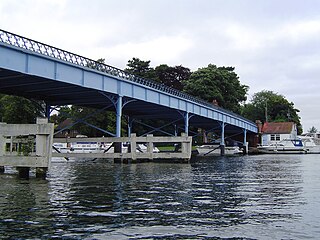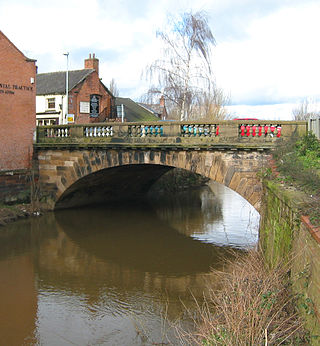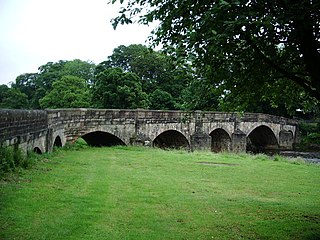
Several bridges named London Bridge have spanned the River Thames between the City of London and Southwark, in central London. It is the oldest road-crossing location on the river. The current crossing, which opened to traffic in 1973, is a box girder bridge built from concrete and steel. It replaced a 19th-century stone-arched bridge, which in turn superseded a 600-year-old stone-built medieval structure. In addition to the roadway, for much of its history, the broad medieval bridge supported an extensive built up area of homes and businesses part of the City's Bridge Ward and its southern end in Southwark was guarded by a large stone City gateway. The medieval bridge was preceded by a succession of timber bridges, the first of which was built by the Roman founders of London (Londinium) around 50 AD.

Hammersmith Bridge is a suspension bridge that crosses the River Thames in west London. It links the southern part of Hammersmith in the London Borough of Hammersmith and Fulham, on the north side of the river, and Barnes in the London Borough of Richmond upon Thames, on the south side of the river. The current bridge, which is Grade II* listed and was designed by civil engineer Sir Joseph Bazalgette, is the second permanent bridge on the site, and has been attacked three times by Irish republicans.

Battersea Bridge is a five-span arch bridge with cast-iron girders and granite piers crossing the River Thames in London, England. It is situated on a sharp bend in the river, and links Battersea south of the river with Chelsea to the north. The bridge replaced a ferry service that had operated near the site since at least the middle of the 16th century.

The Windsor Bridge or Windsor Town Bridge, an iron and granite arch bridge over the River Thames, is located between the towns of Windsor and Eton in the English county of Berkshire. The Thames Path crosses the river here. The bridge carries pedestrian and cycle traffic, and crosses the Thames just above Romney Lock. It is a Grade II listed structure.

Monnow Bridge, in Monmouth, Wales, is the only remaining fortified river bridge in Great Britain with its gate tower standing on the bridge. Such bridge towers were common across Europe from medieval times, but many were destroyed due to urban expansion, diminishing defensive requirements and the increasing demands of traffic and trade. The historical and architectural importance of the bridge and its rarity are reflected in its status as a scheduled monument and a Grade I listed building. The bridge crosses the River Monnow 500 metres (1,600 ft) above its confluence with the River Wye.
Muragh was a tax levied historically in Britain and Ireland for the construction or maintenance of town walls. The term derived from Old French, ultimately from Latin murus meaning a wall. Muragh, also referred to as murage, was generally a term used for the tax meant for the repairs of the defensive walls that enclosed towns in historical England, Wales, Ireland. Beginning as a defence against Viking raids, the tax continued through the Middle Ages before declining in the 17th century, as many town walls ceased to be regarded as important militarily after the English Civil War.
Kingston Bridge is a road bridge at Kingston upon Thames in south west London, England, carrying the A308 across the River Thames. It joins the town centre of Kingston in the Royal Borough of Kingston upon Thames to Hampton Court Park, Bushy Park, and the village of Hampton Wick in the London Borough of Richmond upon Thames. In 2005 it was carrying approximately 50,000 vehicles per day with up to 2,000 vehicles per hour in each direction during peak times.

Folly Bridge is a stone bridge over the River Thames carrying the Abingdon Road south from the centre of Oxford, England. It was erected in 1825–27, to designs of a little-known architect, Ebenezer Perry, who practised in London.

Maidenhead Bridge is a Grade I listed bridge carrying the A4 road over the River Thames between Maidenhead, Berkshire and Taplow, Buckinghamshire, England. It crosses the Thames on the reach above Bray Lock, about half a mile below Boulter's Lock. The Thames Path crosses the river here.

Egham Hythe, Pooley Green and Thorpe Lea are adjacent settlements in the Borough of Runnymede in Surrey, England, approximately 18 miles (29 km) west of central London. They are separated from the town of Egham by the M25 and from Staines upon Thames by the River Thames.

The Old Dee Bridge in Chester, Cheshire, England, is the oldest bridge in the city. It crosses the River Dee carrying the road that leads from the bottom of Lower Bridge Street and the Bridgegate to Handbridge. A bridge on this site was first built in the Roman era, and the present bridge is largely the result of a major rebuilding in 1387. It is recorded in the National Heritage List for England as a designated Grade I listed building, and is a scheduled monument.

Clifton Hampden Bridge is a road bridge crossing the River Thames in Clifton Hampden, Oxfordshire, England, situated on the reach below Clifton Lock. Originally it joined Oxfordshire on the north bank with Berkshire on the south but in 1974 the area on the south bank was transferred from Berkshire to Oxfordshire. It is a Grade II* listed building.

Cookham Bridge is a road bridge in Cookham, Berkshire, carrying the A4094 road across the River Thames in England. It is on the reach above Cookham Lock and links Cookham on the Berkshire bank with Bourne End in Buckinghamshire.

Shillingford Bridge is Grade II* listed road bridge near Shillingford, Oxfordshire, carrying an unclassified road across the River Thames in England on the reach above Benson Lock. The bridge provides access between Shillingford to the north of the river and Wallingford to the south. Originally the south side was in Berkshire but was transferred from Berkshire to Oxfordshire in 1974. The bridge is single track and vehicular passage is controlled by traffic lights.

St John's Bridge is a two-section road bridge across the channel of the upper Thames near Lechlade, England, then across the lock cut to the south, the highest lock on the Thames. It is a Grade II listed building.
Pavage was a medieval toll for the maintenance or improvement of a road or street in medieval England, Wales and Ireland. The king by letters patent granted the right to collect it to an individual, or the corporation of a town, or to the "bailiffs and good men" of a neighbouring village.
Murage was a medieval toll for the building or repair of town walls in England, Wales and Ireland.

Datchet Bridge, also known as The Divided Bridge, was a road bridge which crossed the River Thames at Datchet from 1706 until it was demolished in 1848. It was situated on the reach between Old Windsor Lock and Romney Lock and linked Windsor on the Berkshire bank to Datchet on the Buckinghamshire side. The bridge replaced a ferry service which had operated at the site since at least the middle of the 13th century.

Nantwich Bridge is a stone bridge carrying Welsh Row over the River Weaver in the town of Nantwich, Cheshire, England. The existing bridge replaces a 17th-century stone bridge; it dates from 1803 and is listed at grade II. An earlier timber bridge known as the Wich Bridge is first mentioned at the end of the 14th century; it is described as having a chapel and shops on it.

Edisford Bridge is a toll-free, nine-span bridge over the River Ribble near Clitheroe, Lancashire, England. A Grade II listed structure and a Scheduled monument, located about a mile WSW of the centre of town, it crosses the river to the civil parish of Great Mitton. The bridge carries the two-lane traffic of the B6243 Edisford Road.
















